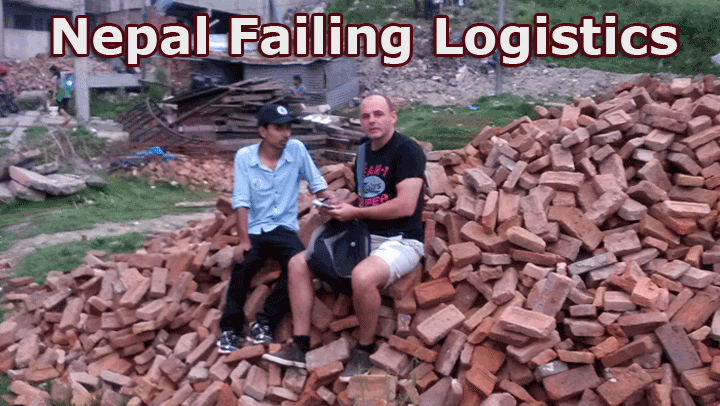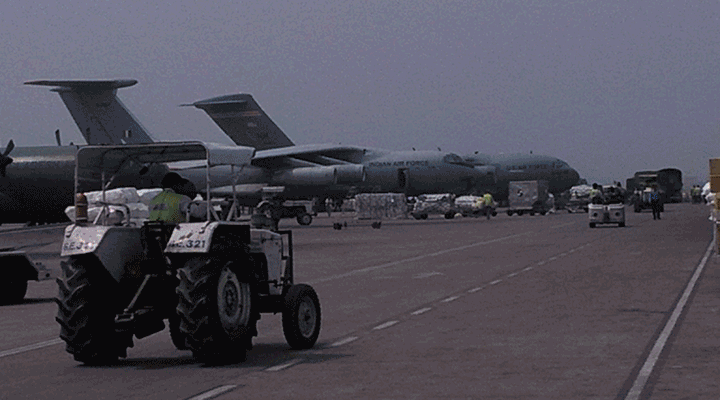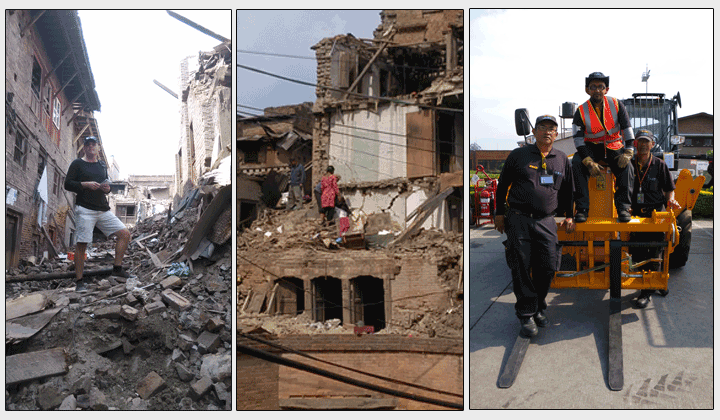
SkyKing with Suman from the village of Sindhupalchowk, where many
families have been rendered homeless.
(SkyKing
In Nepal)—The
humanitarian relief effort into Nepal is being hampered by a failing
logistics network, which is in danger of leaving as many as a million
people without adequate food and shelter ahead of the June monsoon season.
The April 25th, 7.8 earthquake destroyed
hundreds of thousands of houses and left large swaths of Nepal with
no road access. Tuesday’s 7.3 quake caused further damage and
landslides which have made road access even more difficult.
The U.N. concedes that countless families
in mid-hills areas and at higher altitudes have been rendered homeless,
many without medicine, shelter or food, and have still not received
any humanitarian aid.
Multiple sources on the ground - local
villagers and NGOs - also confirm that relief has also still not even
reached villages which are close to roads and within just a few hours
of the capital of Kathmandu, despite time running out before the monsoon
season, which will make providing aid far more challenging.
Chris Weeks, DHL Director for Humanitarian
Affairs who heads up DHL’s Disaster Response Team (DRT) which
has been helping the air cargo handling operation on the apron since
April 27, called what is currently happening “The Perfect Disaster”.
“We have a 7.8 earthquake in a poor
mountainous country wedged between two strong wannabe superpowers [India
and China] with a single runway international airport, no seaport and
15-day road links in a race against time to feed and shelter hundreds
of thousands of people before the monsoon season starts,” he said.
The logistics effort is also being hampered
by bureaucracy, which is driving up the time it takes to truck into
land-locked Nepal from India to over two weeks, instead of five days.
The UN’s World Food Programme (WFP),
which is co-ordinating the humanitarian logistics for all NGOs, lacks
funds, equipment and access to military assets.
“We have a few civilian helicopters
to find people in need,” said Alex Marianelli, regional Logistics
Officer at the WFP. “For all of our operations, especially at
higher altitudes, we need to first scope who needs help and where they
are. But without enough helicopters this is difficult.”
The UN’s effort has been further
hindered after a UK aid package which included three Chinook helicopters
ideal for deployment in Nepal were refused permits to operate. They
remain on standby in India and their handling equipment, including a
K Loader at KTM, stands unusable.
As a result of the lack of trucks, and
the bureaucracy experienced at the India-Nepal customs intersection,
most of the inbound relief effort continues to focus on air freight.
 |
Nepal has only
one international airport – Tribhuvan Kathmandu International
Airport (KTM) – able to receive freighters. KTM has just nine
parking stands and one runway. It lacks dollies, slave pallets and forklift
trucks. The runway was damaged soon after the earthquake relief effort
began. The upshot is a 196 tons landing and take-off limit which has
pushed the emphasis on aid onto smaller IL76s rather than the larger
freighters required. Charter costs for NGOs have soared as a result.
The relief effort via KTM is also being
hindered by geopolitics and red-tape. The rival militaries, including
the U.S., are competing for landing permits and space and, despite the
severity and urgency of the situation, passenger flights are still being
given priority over chartered aid freighters by Nepali authorities.
The result is that over 500m tons of relief cargo is currently awaiting
delivery by air from Delhi. Hundreds of tons more is being also stored
at airports around the Middle East.
After Tuesday’s earthquake multiple
freighter landings were cancelled and reports received by FlyingTypers
yesterday and today reveal a working environment at KTM that is not
improving.
One charter representative on the ground
told FT today that the difficulty of organizing permits had
in fact further increased in recent days with Nepali authorities requiring
full cargo details and AOCs from consignees before granting permits.
Even when permits are secured, they are often subsequently cancelled.
“If anything, the situation is getting
worse,” said the charterer. “They cancelled my slot and
many others’ yesterday. We are still hitting a brick wall everywhere
we turn. I’m running in circles trying to get all the correct
paperwork.”
A spokesman for Volga Dnepr said the company
appreciated the enormity of the humanitarian challenge the Nepalese
authorities were dealing with. But he added: “It is very challenging
to get slots and landing permits and this is resulting in delays in
terms of the transportation of aid into Nepal.
 |
There are
a lot of different authorities involved in what is a complicated process
to obtain the necessary operating authorizations. Obviously this makes
planning very difficult, particularly when aircraft are also committed
to other customer flights around the world.
“We operated another flight into
Nepal this morning and we have a permit for a further flight in the
next few days. No other flights are currently planned but this is obviously
a very fast-changing situation and given our expertise in humanitarian
and aid flights we expect to receive more requests in the coming days
and weeks.”
Marianelli said that, as things stand,
the WFP did not have enough assets to reach communities unable to walk
to major roads. “Near the Indian and Chinese border there are
entire communities and no one can get to them in the traditional ways,”
he said. “When the cold weather comes, they are in trouble. We
need to do this in the next three weeks, but in some entire regions
I only have one helicopter to scope them. At the moment we think 1.4m
people are highly affected and need relief now. How many are totally
isolated is a picture I’m working on. But we’re running
out of time.”
SkyKing
Editor's Notes: SkyKing is working with a charity to raise USD $50,000
for Nepal humanitarian efforts. This will be enough to feed and provide
shelter through the monsoon season for almost 600 families in Sindhupalchowk,
many of whom have been left homeless.
The devastation to the morale of Nepalese citizens is difficult to quantify,
but after having been struck not once, but twice, it can only be assumed
the citizenry is in the direst of straits. If you would like to donate,
please click here:





